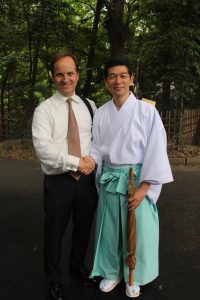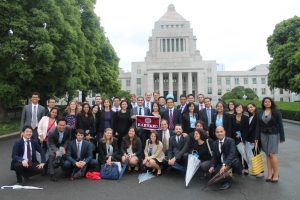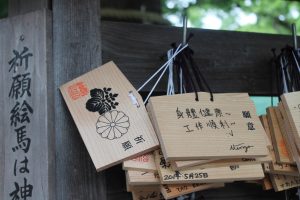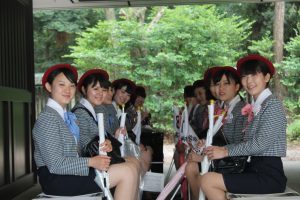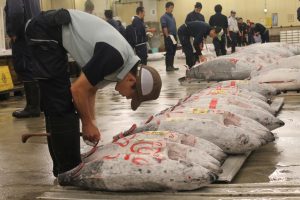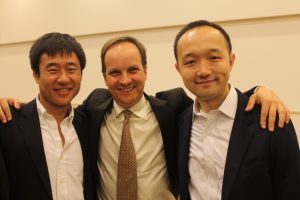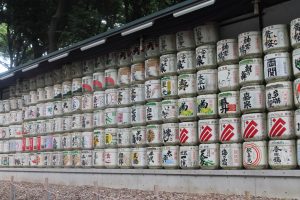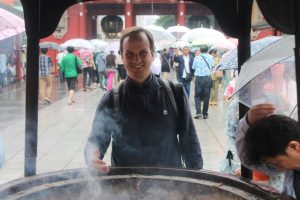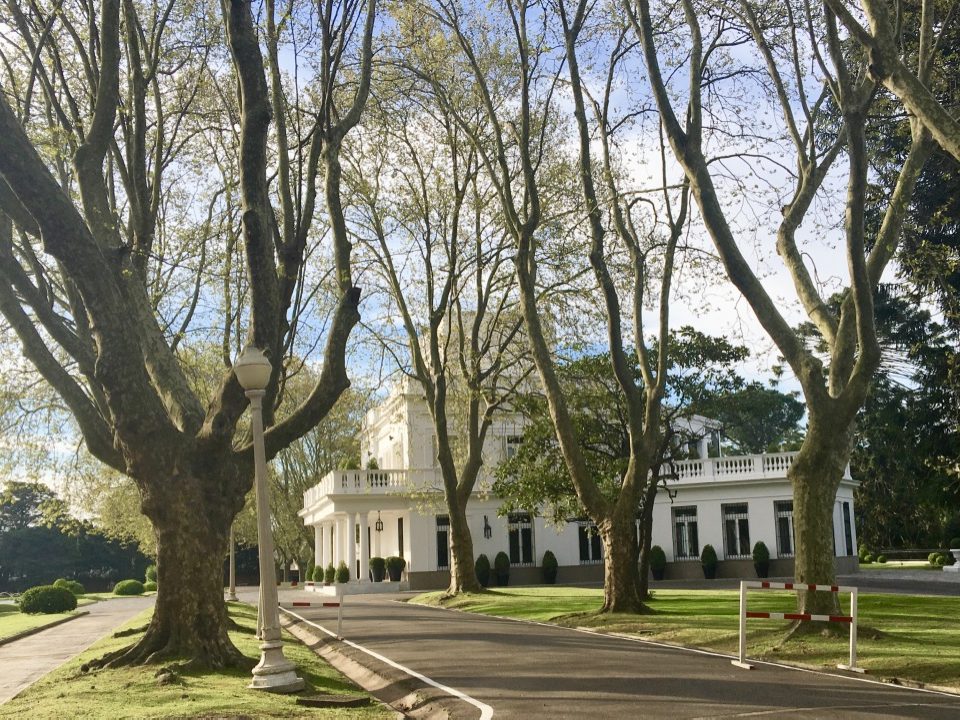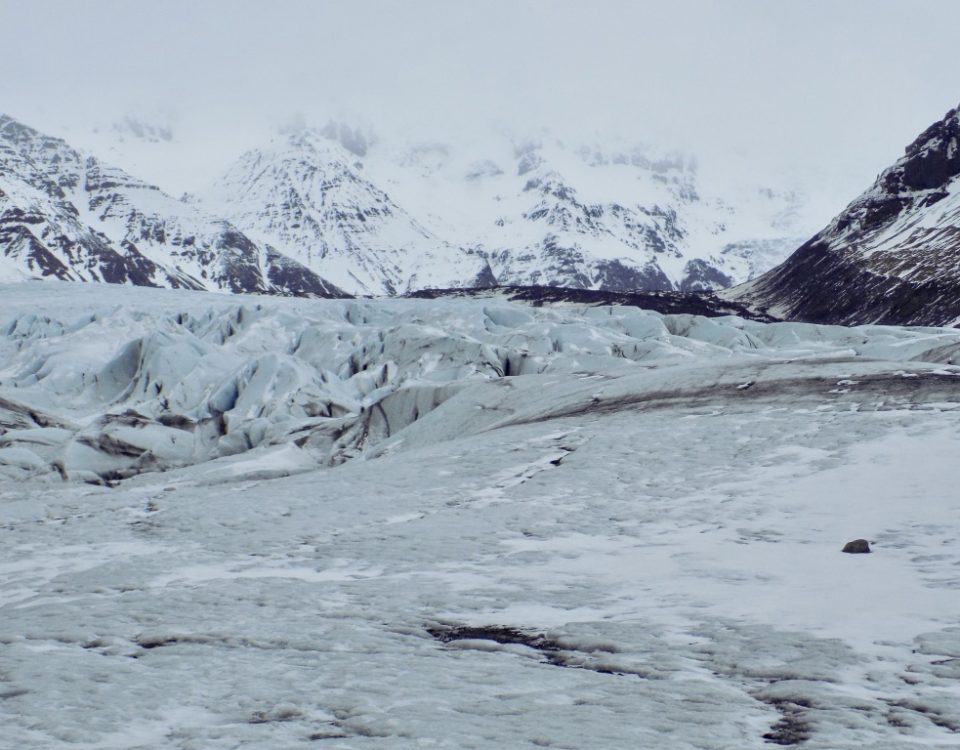Japan

IN SEARCH OF JAPANESE NATIONAL CHARACTER: A JOURNEY INTO THE LAND AND CHARACTERS OF HARUKI MURAKAMI
“Things change every day, Mr. Nakata.
With each new dawn it's not the same world as the day before.
And you're not the same person you were, either.”
― Haruki Murakami, Kafka on the Shore
An octopus. My memories of entering Tokyo for the first time will always be ones of traveling throughout the tentacles of an enormous octopus, made of brick, mortar and steel. All the green stretching from Narita airport to the city came to a sudden end, and got devoured into a jungle of concrete. I remember entering the capital through an elevated highway, which I guessed might have been at the level of the seventh or eighth floor of the buildings surrounding us. As far as I could see, ours was just one in a network of roads that crisscrossed and twisted from below and above in different directions.
Like vehicles, pedestrians have their own set of lofty passages, floating above the urban uproar and connected between themselves, and every now and then, to the street by staircases. Later on that same night, I gave into my curiosity and ventured into these tentacles on foot. For any traveller, those firsts compasses foraying into alien streets are fueled by a rapid succession of somewhat surreal images. For a Venezuelan, a Latin American at last, the sensation of entering into a science fiction movie is even stronger. This is somewhat understandable. The sole mention of Japan awakens a collage of mental images comprising technological advance, managerial techniques bordering on mythology, war scenes domineered by gruesome characters, dreamlike fantastic snow passages from Kurosawa’s movies, and, of course, transient characters coming out of Murakami’s novels.
It is that desire to contrast all these pieces of mental scenery with the reality on the ground what inspired me to join into the Harvard Asia Leadership Trek and write about Japan. I have been exposed to different threads of Japanese culture throughout my life as a corporate officer, economist, and reader. Quite often, I found myself puzzled by the stark contrast between different traits and features embedded in the “Japanese national character”. On the one hand, there is the preconception of the quintessential efficiency, the child portrait of corporate competence, timely and to some extent cold, carried into the Japanese corporate practices: total quality, just in time, robust design, Taguchi method of quality control, and so on. Then there is the violence, the coldblooded violence, registered on numerous accounts of war episodes, and to some extent gathered in different manifestations of Japanese art. At last, these two somewhat collide with the ephemeral characters populating the novels of Haruki Murakami, parallel realities people feel inevitably drawn to, the idea that destiny is too strong a force to resist, that reality and fiction have blurry limits and are actually intertwined with each other, your own personality conformed and somewhat determined by an uncontrollable set of external occurrences out of our control.
“The earthquake is approaching: Do not rush”
As it is well known, Japan happens to be one of the areas of the world most prone to natural disasters. The Japanese have proved defenseless against the sudden onslaught brought by events such as the Kobe earthquake in 1995 or the earthquake and ensuing tsunami registered in the Pacific coast at the region of Tohoku in 2011. These disasters have most certainly left an imprint in national character, which has responded by counteracting capricious natural disasters with astonishing steadiness and predictability.
One of the greatest tools in achieving this superhuman stability in the face of catastrophe is the Japan Broadcasting Corporation (NHK), whose headquarters we had the opportunity to visit. Having worked on TV and media for a number of years, I was stunned at the prospect of paying twenty-one dollars a month for a single TV channel, which focuses mostly on news, disaster prevention, historical documentaries, and culturally-inspired dramas. Who is going to buy that? As it turns out, a lot of people do. Indeed, these hefty subscription fees pay up to 96% of the annual budget of the station.
To help us understand why, we were shown some samples of their coverage during the earthquake and tsunami of the Pacific Coast at the region of Tohoku (official name) - and then it all became clear. The scene begins with a meeting of congressmen of the Japanese Diet; not the least bit exceptional in and of itself. A blue warning box appears in the lower part of the screen and a calm, firm voice supersedes that of a chubby congressmen who at the time was on the microphone, leaning forward and reading from a stack of papers he held in his right hand: This is a quake warning. A strong earthquake has been detected at Miyagi, Iwate, Fukushima, Akita, and Yamagata prefectures in Tohoku area. Interestingly, the meeting in the Diet goes on as usual, with a member - I presume by his gestures - opposing the previous speaker.
It is then 2:45PM on March 11th, 2011. NHK highly sophisticated equipment has detected the seism epicenter some minutes before it hits the island. The third or fourth time the same warning message is repeated; the overlay voice goes on to say that an earthquake will occur soon. A full minute after the first warning you can see the people in the Diet looking up at the ceiling. You can sense some uneasiness but not yet uproar, as they talk to each other. As the camera goes up, two huge chandeliers on the ceiling start swinging. I have this image fixed in my mind: the chandelier swinging while all the white flashes coming out of the congressmen phones pound the walls and light the screen. And you can barely hold yourself in those small theater chairs where we have been seated: Get out now! Get out!
It is then that the camera shot moves into the NHK studio, where we can finally see the face of the broadcaster – this time issuing a different warning: Earthquake hit the Tohoku area at 2:46PM. Please be aware of tsunami in the coastal areas of these regions. The earthquake has now moved into Tokyo. Then, as some people shout on the other side of the camera, he proceeds to announce that our studio in Shibuya is swaying right now, and the camera moves back to focus on him, staring straight in spite of the trembling; the palms of his hands pressed firm on the table. After some difficult breathing, as people around him break in screams of alarm, he continues: I repeat, the earthquake has moved into Tokyo. Please, proceed to evacuate, do not rush, and pay attention to things dropping from the ceiling and furniture halls.
This was not the first time I have learnt of Japanese people exhibiting unfathomable poise and self-control in the face of tragedy. A few months before, I have read Underground: The Tokyo Gas Attack and the Japanese Psyche, by Haruki Murakami. I had highlighted, somewhat in disbelief, a full section on a particular interview with one of the victims: “Then a middle-aged man came walking from that direction saying ‘Sarin, sarin!’ Hearing that, several people around me stood up, although they did not seem in any particular hurry. They were not running to escape, or anything of that sort.”
It was yet another Japanese display of resilience and steadfastness in the wake of unexpected danger. It is as if people suffering from these events had decided to stand up quietly and not display any sign of weakness, as if their mere standing calmly in front of danger were their very personal way to process catastrophe, a sort of internal rebellion against the assault of nature. Once the danger is gone, in spite of all of its devastation, what prevails is the attitude of the hero, not of the victim. It is a very conscious choice. As one of the victims of the sarin-attack declares: I have never seen myself as a victim. I am a survivor.
By its mere placement on the corner of a globe surrounded by the tensions of tectonic plates, all Japanese are, by definition, survivors. Each one seemed to carry the moral fibers of a hero, defying natural human fears. And yet this was not only in its geographic location, but also its unique history of both victim and perpetrator.
“Corruption? Go ask the Chinese!”
As a kid growing up in the late seventies, I experienced Japan’s transformation from a unique perspective. I witnessed the gradual change in the feelings elicited by the seal “Made in Japan”: All the way from basic, cheap, and disposable; to high-tech, expensive, long-lasting, and efficient. Subsequently, I was thrilled by the opportunity of visiting the Japanese Diet and exchanging views with government representatives about the economic policy plan of Prime Minister Shinzo Abe.
The economic policies enacted by Abe since his 2012 reelection, often referred to as Abenomics, rank up in economic notoriety as the highly-touted Reaganomics and Clintonomics. After decades of sluggish growth, the newly elected Prime Minister launched a set of measures aimed at stimulating growth and “reflating” the economy. His remedy for growth is hardly original, including expanding public investment and fiscal expenditure. However, what makes it so interesting is how controversial it is in light of the 2008 worldwide recession. By enacting Abenomics, Japan entered the worldwide faceoff between the conservatives advocating austerity and liberal interventionists (on the latter’s side).
To me, Abenomics seems a particularly risky bet, since it has led to a double-digit fiscal deficit in a country where debt-to-gross domestic product (GDP) ratio is well beyond 220%. Even more, there seems to be a lot at stake besides Japanese economic prosperity; national character seems intrinsically intertwined with its prosperity and its perception abroad. First and foremost on my mind as I entered into a meeting with congressmen from Shinzo Abe’s Liberal Democratic Party (LDP) were tough questions: When is growth expected to resume? How is its fiscal debt going to be paid?
However, their responses were short and standard, as if coming out of a script prepared for the occasion. We do trust Abenomics. Growth has already started to pick up. No, we will not have any trouble servicing our debt. And then at some point, while discussing about relatively neutral and dispassionate economic topics, an older man made a loaded comment that drove our conversation into a different, much more interesting, route. Well, our national debt is in the hands of the Bank of Japan, the trusts funds of the country, our citizens. We are not like the United States… they are in the hands of the Chinese.
In any case, the condescending tone of voice and unconcealed bitterness were the first signs of a deeper issue that surfaced many times throughout the meeting. When asked about corruption and anti-corruption practices in Japan, the same man rushed to say: If you want to talk about corruption, then go ask the Chinese! It is an easy line that incited laughter in the rest of the panel and a good share of nervous smiles and frowns within our group. Then he moved into a rant on Chinese government corruption, faulty business practices, lack on enforcement on intellectual property laws, etc.
This bitterness once again manifested itself when the congressmen were inquired about the escalating territorial disputes that Japan has held for many years with Korea (Liancourt Rocks) and China (Senkaku islands for Japan, Diaoyu for China, Tiaoyutai for Taiwan.). The old man returned the question, asking back if we knew the history of those islands… because if you knew the history, you would not be asking these questions. There is no doubt from a historical standpoint that these islands belong to Japan… this is something we are not willing to discuss with anyone. As it turns out, the economy, corruption or even the islands, are not the point. These are rather manifestations of the deep resentment and distrust that populates the relationships between Japan and its neighbors.
As I would sense on the remaining of our trip to Seoul and Beijing, the language – when it comes to talking about neighbors – becomes very harsh; words like humiliation, cruelty, repair, apology, criminal, often predominate over the conversations. There are deep scars from old wounds, in most cases coming out of war crimes, which have not healed, and keep on surfacing.
It was probably natural, because of the flow the conversation had taken, that one of our last questions dealt with means of improving bilateral relationships, probably by honoring other nations’ pain, recognizing crimes and apologizing… If they are waiting for us to apologize, they can keep on waiting.
“We are the real drivers of Japan’s strength”
The National Identity Is There, But What Exactly Is it?
The majority of what I knew previously about Japan came from my previous life in the private sector – albeit, it was somewhat limited. Receiving my MBA and later working in large corporations, I was constantly bombarded with new and improved managerial practices coming out of Japan. It was from Japan always that the “new, new thing” that would transform our working methods, making us as efficient as them, would come.
We, the unfocused, capricious, feisty, and careless Latin Americans had to learn from the industrious, predictable, disciplined and timely Japanese. In order to achieve such an improbable feat we had to inhale from the essence of a number of Japanese recipes, which we had to swallow in rapid succession. Total quality, zero-defect policy, robust-design, Taguchi statistical control of productive processes (continuous and discontinuous), just in time, et cetera. They kept on coming and overriding each other, no matter how much we had assimilated from the previous one. It was a sort of centrifugal force that accelerated at a speed that was inversely proportional to absorption.
And then, ironically, instead of the great managerial efficiency I had expected, there I was, grabbing a wide pink umbrella provided at the door of our bus and running (we are late!) into the Mitsubishi headquarters in Tokyo. Having waited half a lifetime to visit the laboratory of progress, sure I can wait a little longer. The problem being, if I may suggest a small improvement to Japanese business etiquette, that we have been running from meeting to meeting without being offered coffee.
I have mixed feelings regarding our visit to Mitsubishi. We were given the classic investors’ relations talk in full, including history, organization, operating performance, market shares, and earnings. It was so standard that I had trouble making some meaning out of it. The most salient aspects of the day were to be found not so much in content, but in form. The talk was given by a very senior executive; a man that was likely in his late sixties, who addressed the group in an extremely formal way. Interestingly, there was no mention of past failures, no learning from previous wreckages. Instead, there was this all-encompassing attitude of this is Japan, and we know how to do business here.
One might assume that all the Japanese companies, as they integrate into a globalized world, have been forced to change, compromise, and adopt some of the business practices from the West. I cannot help but think that this transition must have been a tough one for Japan. The resilience of Mitsubishi executives, their pride on the Japanese way of doing things, is only a hint of how difficult it might have been for Japanese corporations to gradually adopt and adapt to the business practices of the West. Sure, it was a transition carried more out of necessity than conviction.
Another interesting aspect of these Japanese corporate talks is how much they keep on insisting on the West “learning and assimilating the Japanese way of doing things”, without actually providing any significant detail as to what does that means or which specific types of behaviors it entails. I understand that understanding Japanese is important to make business with them and figure out their success, but the specific of that “Japanese way” continues to elude me.
As our visit to Mitsubishi immediately followed that of the Japanese Diet, I took advantage to share – and test – some of my insights from the latter with two executive hosts that we assigned to sit with us at the lunch table. I wanted to see their reaction and grasp if they could possibly match my descriptions and the names of the congressmen and provide some background. Not a hint. It seemed to me as if they had little or zero political awareness, and could not have cared less. When you live in Japan, you do not really care about government. We barely talk about politics, our Prime Minister, or the Diet. After all, they are not the reason behind Japan’s strength. We are.
It is then that I realize that, with each conversation I had and each person I encountered, my vision of the Japanese national character became more jumbled and less cohesive. Nothing seemed to match. The business and political spheres seemed to have different ideas of the Japanese national character. The national character was indeed paramount – it has led to wars and imperialism and business legend – but yet I could get a hint and no one could tell what it was made of.
“Japan is changing. But it is hard to say if it is changing for good”.
My Disorientation in the Elusive Search for the Japanese National Character
One night at a cocktail at the Japan International Cooperation Agency (JICA) Sadaka Ogato, former head of JICA, showed up and improvised a speech. There I learnt that Mrs. Ogato was a sort of legend, widely known – among many other appointments – as former United National High Commissioner for Refugees (UNHCR). She had a soft voice that did not match with her body language of strength and defiance, and it was hard to understand from the point where I was standing. In spite of that, I distinctly remember her saying: “Japan is changing, there is no doubt about that. But it is hard to say if it is changing for good.” It was a challenging thought for me. I hardly understood the current Japan – despite my studies, my invitations to impressive institutions and companies, and my deep desire to learn more. The idea that it was changing was overwhelming to me and left me feeling as if I were drowning in a sea of unknowing.
I began to panic, feeling as if I were leaving Japan without reconciling the many aspects of Japan’s national character I had experienced. Subsequently, I reserved my fourth - and final - day in Tokyo to try to catch a glimpse of the real Japan. It was not so much that what we had seen so far was “unreal.” But admittedly, all these days we had attended very selective exhibitions displaying the muscle of the strongest segments within the Japanese society.
I woke up at 3:30am to secure being among the 120 lucky souls allowed in for the Tuna auction at the Tsukiji market starting at 5:45m. After the auction, we went into the market for a superb sushi breakfast. However, I was a bit disappointed that – in spite of being in the middle of a large number Japanese witnessing a sort of traditional daily scene not staged for tourists – any trace of originality and distinctiveness remain elusive. Everything was precisely neat and clean, the auction site itself, the ensuing daily fish market, the restaurants around, and even the small food stalls. The organization of the overall space and within each of these places was highly noticeable. In spite of the chaos characteristic of weekend markets, Tsukiji ran smoothly. Nothing even seemed to be out of place, no misplaced garbage; everything flowed like clockwork. If anything, Japan is a country with no surprises.
That evening, however, I did encounter a surprise. As we experienced the nightlife at the Akasaka and Roppongi districts, I could not help thinking how different young people here look when compared to the ones we have met throughout our meetings this week. Instead of white collar job attire, they wore bold colors. Even their hair was colored in blue, red, purple, and green. It was not only that; it was their way of dressing, their tone of voice, and even how they walked. It was clear that they deeply desired to mark a difference and manifest their individuality. It is as if they had just broken a chrysalis of Japanese traditions and were out in the world to reassert themselves. However, instead of providing any clues by which I could thread together the Japanese national identity, this experience just provided one more piece to a puzzle which seemed increasingly impossible to solve.
Those midnight walks though bars and karaoke places do provide a certain glimpse into a sharp contrast between what Japan has been and what it is gradually becoming. I somehow have trouble figuring out these young, bold, color full, rash and rebellious people, evolving into the sort of older, orderly, methodic, cold and prudent characters I have been visiting these days. I feel that, once these young guys make it there, they are not going to be the same, and our image of Japan might change. Or maybe not. Maybe they will slowly enter into a certain channel, and prove that, after all, that national character and identity that I have found so elusive, does exist. Maybe these different Japans coexist, as parallel realities and worlds, quasi-independent of each other. Maybe there is a door somewhere in the city connecting these worlds, that only a few privileged and chosen can trespass. Pretty much as in Murakami´s novels.
Sayonara.
Miguel Angel Santos

